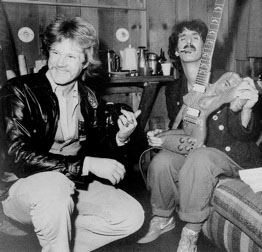The Cover Art

When Frank and Herb broke their relationship [in 1976], and all the work stopped, I had to move out of my place. So I thought it would be a good time to leave LA for a while, and I went back to Pennsylvania to paint and spend time with my family. I visited LA in 1980 and reconnected with Zappa, so I started doing work for him again—that's when I did the Tinsel Town cover.
Cal Schenkel, interviewed by Barry Miles, Mojo, March, 1994
I did that piece for a tour book, a quicker version, then Frank said,
"Why don't we use this for the cover?" and I said, "Well I can do a more involved
version." So I got involved.
The Sources
Charles Ulrich, February 10, 2015
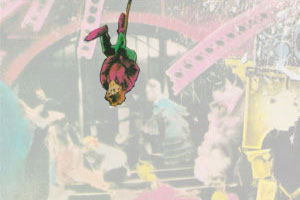
Lon Chaney as The Hunchback Of Notre Dame is hanging upside down.

Javier Marcote, February 10, 2015
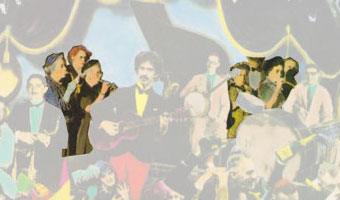
The [three] old women who are playing some kind of toy saxes (or similar) on the left side of FZ, appear in this photo which belongs to Cal Schenkel magazine (Sept. 1981).
On the right side of FZ on TTR cover and behind the seated banjo & drum players, appear two more women and a man behind them which also correspond with photo above.
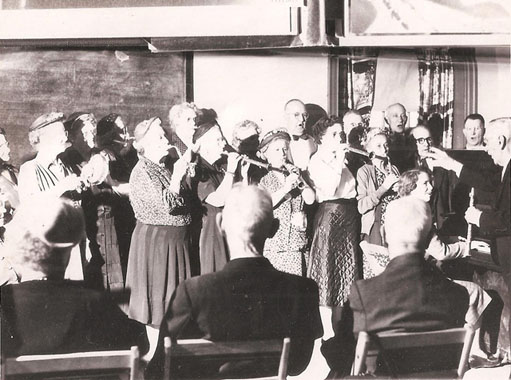
Javier Marcote, January 14, 2018
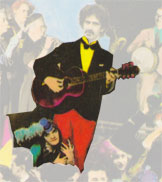
I found out that Cal Schenkel used the image of Nick Lucas, playing guitar, & Winnie Lightner, gripping to his leg, from the film "Gold Diggers Of Broadway", 1929; for the image of FZ and the girl below him for TTR cover.
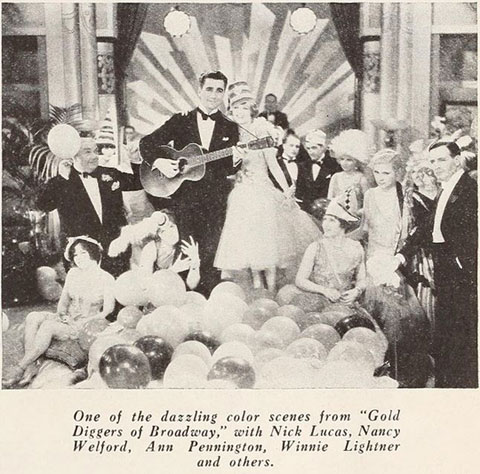
Charles Ulrich, February 10, 2015
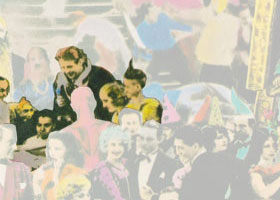
Minnie Woolsey, Schlitze, Angelo Rossitto, Wallace Ford, Leila Hyams, and Elizabeth Green in Tod Browning's Freaks (1932).

Javier Marcote, August 11, 2015
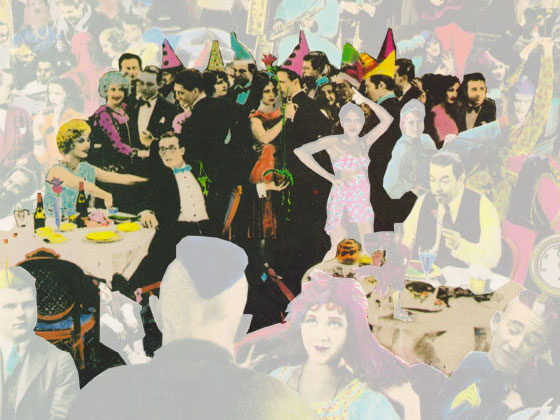
[I've found] this promo photo that Cal used for the cover of TTR:
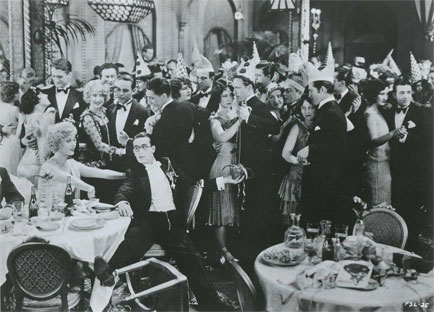
[Harold Lloyd's World Of Comedy (1962) and Harold Lloyd's Funny Side Of Life (1963) promo still]
Charles Ulrich, January 13, 2018
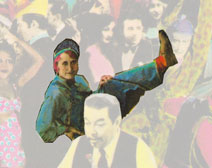
I've long thought that the woman doing the high kick behind Charlie Chan on the cover of Tinsel Town Rebellion was Charlotte Greenwood.
Tonight I think I've identified the still, from a 1931 short entitled Girls Will Be Boys:
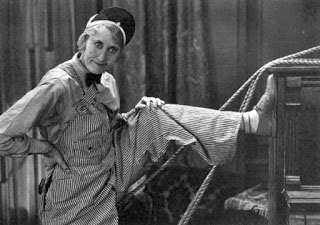
Notice in particular her headwear and the long crease in her pant leg. The still is rotated counter-clockwise a bit on TTR.
Kjell Knudde, September 6, 2014
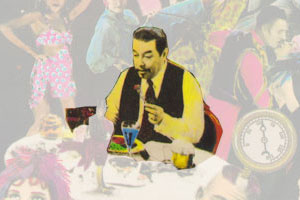
Warner Oland, from the 1937 Charlie Chan movie "Charlie Chan on Broadway".
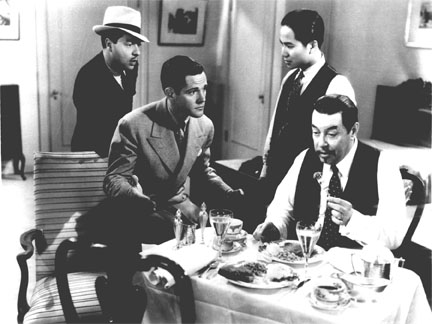
Kjell Knudde, September 6, 2014
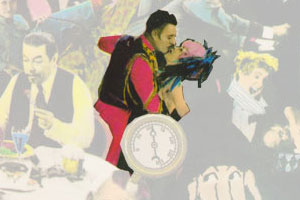
The couple behind [Warner Oland] are John Gilbert and Mae Murray dancing in the film "The Merry Widow" (1925).

Javier Marcote, January 14, 2018
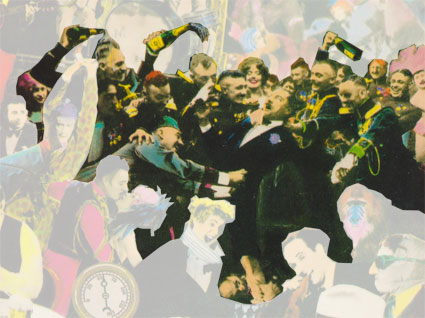
I found this newspaper clip from where Cal picked-up this image of "the riotous nobility" for the cover.
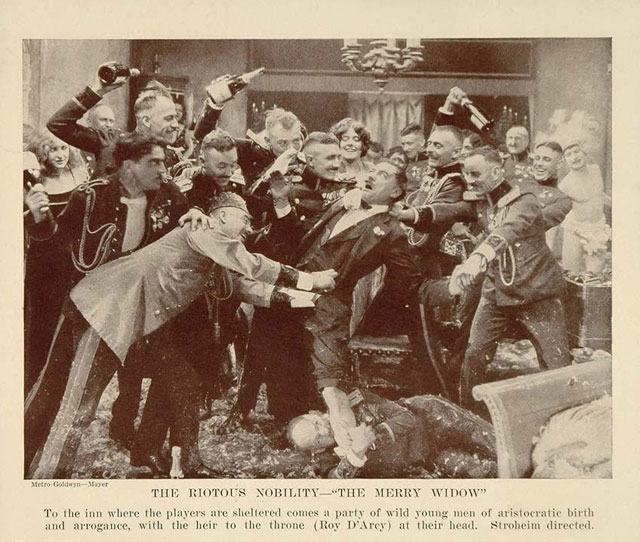
Charles Ulrich, July 21, 2010
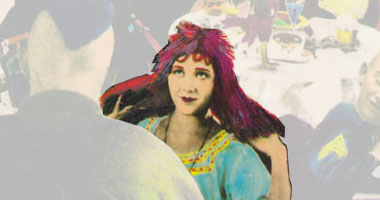
It's Mary Brian as Wendy (opposite Betty Bronson) in Peter Pan (1924). Hanson's The Peter Pan Chronicles (p. 128) has what I think is the exact same still.

Kjell Knudde, January 27, 2015

I found another image on "Tinseltown Rebellion"'s album cover, this time on the far right down below, where you can see a man with a bandaged head and green glasses.
It's Claude Rains in "The Invisible Man" (1933). Here is the photo it was lifted from:
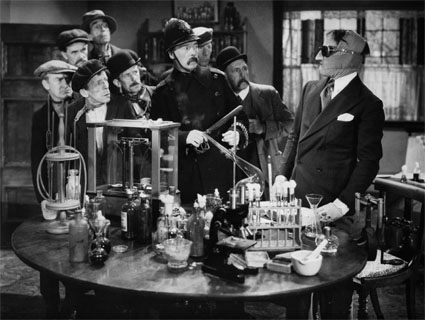
Charles Ulrich, February 10, 2015
At least the seated saxophonist—and possibly the rest of the band—is from the Clicquot Club Eskimos. There's a different photo at <http://www.redhotjazz.com/eskimos2.jpg>.
Calvin himself is behind the Fine Girl. Above him I think is Clifton Webb. The Fine Girl is facing Harold Lloyd. I think the woman doing the high kick behind Warner Oland is Charlotte Greenwood.
Charles Ulrich, August 10, 2015
I've confirmed Clifton Webb on the cover of Tinsel Town Rebellion (below Freaks and above Cal Schenkel). And the woman with him is indeed Gene Tierney. The still is from Laura (1944), about twenty-five minutes in.
The score of the film is by David Raksin (1912-2004), who introduced FZ to Zubin Mehta, conducted a rehearsal for the Royce Hall concerts, moderated An Evening With Pierre Boulez & Frank Zappa, and attended recording sessions for The Rage & The Fury.
The Original Collage
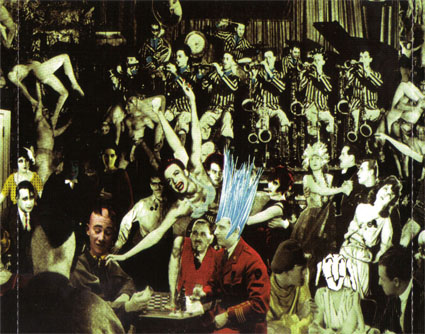
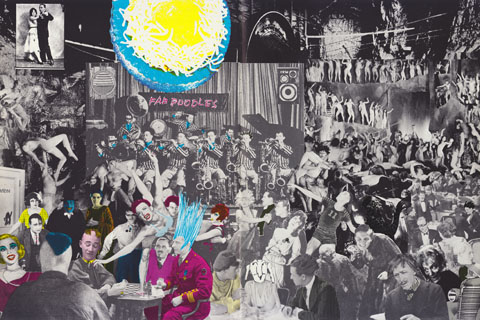
Kjell Knudde, January 27, 2015
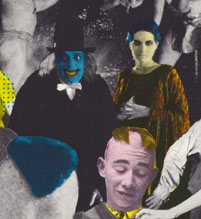
And from the interior cover of "Tinsel Town Rebellion": the two people on the left are Lon Chaney and Edna Tichenor from the lost horror movie "London After Midnight" (1927).
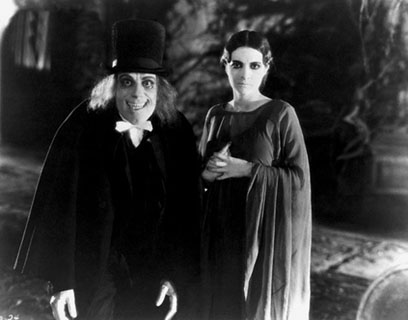
Javier Marcote, August 14, 2015
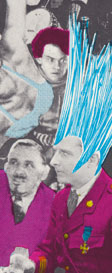
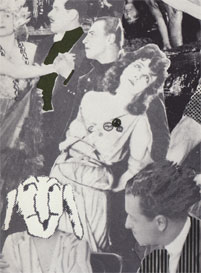
It belongs to " Warning Shadows", 1922. Macabre German film. Production: Defu. Direction: Arthur Robinson. With Fritz Körtner, Fritz Rasp and Ruth Weyher.
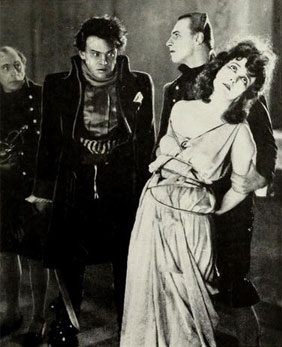
Javier Marcote, January 14, 2018

Häxan, it's a silent horror Danish-Swedish film by Benjamin Christensen known as "The Witch" or "Witchcraft Through the Ages", 1922
https://www.youtube.com/watch?v=CkXlXc0lA9c
I found out this sorcerer:
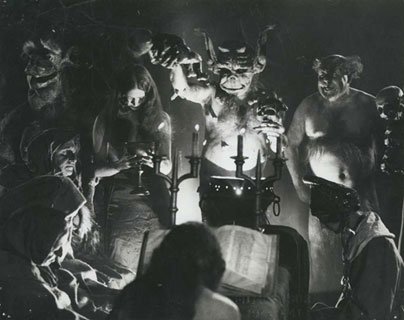
Javier Marcote, January 14, 2018

From the movie The Dancin' Fool, 1920;
The actor Wallace Reid, left side of the attached image; the face of the actress Bebe Daniels was replaced by the drawing of [Ralf by] Cal Schenkel.
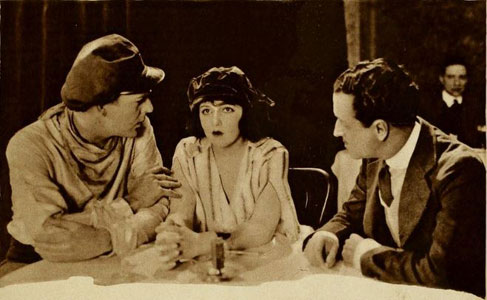
Charles Ulrich, July 20, 2010
The hell scenes in the fall 1980 tourbook are from Dante's Inferno (1924). Blum's Pictorial History Of The Silent Screen (p. 264) has a still taken a few seconds before or after the group shot on the mid upper far right.
The Disappearing Engineers
engineers: Mark Pinske, George Douglas,
Joe Chiccarelli, Alan Sides, Tommy Fly
re-mix engineer: Bob Stone
Digitally remastered by Bob Stone
The actual real album credits, which unfortunately are only on the albums themselves, "produced by Frank Zappa; engineers: Mark Pinske, George Douglas, Joe Chicarelli, Allen Sides, Tommy Fly; remix engineer: Bob Stone; disc mastering: Joe Hansch from K-Disc." So the tracks that we used were tracks that I did. There was a couple of tracks that George Douglas did on a 4-track from live. There were tracks left over from Joe Chicarelli, and then Allen Sides and I did a lot of recording together, even after this, on You Are What You Is, I think Allen did some recording with me, too, in the studio and out of the studio, and also, Allen did some of the live tapes at the New York Palladium. Before we had the truck, we rented the Record Plant truck. And Allen had done that. So the actual credits on the real album are myself first, George Douglas, Joe Chicarelli, Allen Sides. The albums had all the original credits, and little notes by Frank, according to how things were done originally. Later on, just so you know, I had a little bit of a mini fallout with Gail, after I had left Frank. And because of that, she started striking my name off a number of things. She was kind of mad at me over another issue. Really what it was about is, she tried to order me to do some things, and Frank told her that I worked for him. And pretty much told her off. That put a little bit of a bad nail between the two of us. So later on, when they did all this repackaging stuff, she just decided to skimp on the artwork and everything else. And think some of them was to save money, of course.
Mastering
Mix: Tinsel Town Rebellion was originally released as a double LP. Did you get involved in the mastering process for Frank's albums? I think you answered that.
Pinske: That was Joe Hansch at K-Disc. Joe and I did the mastering together on that. He's on a number of albums. Let me get the spelling correct for you on that. At that time, he was at K Disc. Before that he was at KenDun Recorders. And then we moved from KenDun to K-Disc.
Release History
CD-R on demand (Amazon.com/Zappa Records, January 25, 2010)
CD-R Note: This product is manufactured on demand when ordered from Amazon.com.
[...]
Audio CD (January 25, 2010)
Original Release Date: May 17, 1981
Number of Discs: 1
Format: Live
Label: Zappa Records
ASIN: B0000009T1
[...]
1. Fine Girl
2. Easy Meat
3. For the Young Sophisticate
4. Love of My Life
5. I Ain't Got No Heart
6. Panty Rap
7. Tell Me You Love Me
8. Now You See It—Now You Don't
9. Dance Contest
10. Blue Light
11. Tinsel Town Rebellion
12. Pick Me, I'm Clean
13. Bamboozled by Love
14. Brown Shoes Don't Make It
15. Peaches III
2. Easy Meat
I created that, those were my harmonies. Frank let me go for it totally. I actually had that worked out. A lot of the classical songs, I wrote out, like the solo on 'Why Does It Hurt When I Pee?', the melody there. The reason I wrote it out is because that was one of the little instrumental eight bar solos that I would get. But one night, I had a mental block. That had never happened to me before one of my solos. I tried to make it interesting all the time. So I stayed up all that night and wrote the part out for myself so in case that ever happened again, I would always have at least a cool solo. And shit like that I actually wrote you know. It was part of the arrangement and we wrote it out.
Track content
| Easy Meat (TTR) |
Content |
| 00:00-02:58 |
Crush All Boxes version (with overdubs)—Upper Darby, April 29, 1980 |
| 02:58-03:10 |
"Sink Trap" improvisations, UCLA, September 18, 1975 |
| 03:10-03:19 |
Läther grout |
| 03:19-09:19 |
Santa Monica, December 11, 1980 (early show) |
I can't get off on the Rollin' Stone
But the robots think it's great
Steve Vai, 2nd Annual Surround Music Awards, December 11, 2003
Speaking of Rolling Stone, I don't think Frank had any soft spots in his heart for them being that they once said that the only good stuff he every released was his first few records. I remember he and I were sitting in the studio recording once, me with my guitar and he at the helm of the tape machine, and his secretary excitedly entered the room. She said Rolling Stone just called and they want to put him on the cover. Frank responded with, "Why the fuck should I help them sell their magazine" and then he hit the record button and we continued. Now, there's one thing cooler than being asked to be on the cover of Rolling Stone, and that's turning it down.
6. Panty Rap
we are collecting underpants, and we are collecting brassieres, we are collecting small articles of feminine underclothing. We are making a quilt . . . really—trust me.
Liner notes, 1981
ALSO . . . the business about the underpants and making a quilt out of them etc., well . . . it's really being made (yes, right at this very moment) by a lady artist in Lyons, Colorado named Emily James . . . and, as if that weren't exciting enough, Ms. James insisted that all those lovely little under-garments you donated at the concerts NOT BE WASHED, thereby maintaining some exquisite sort of organic miasma in the vicinity of the finished work of art. She estimates it will take her a year to complete, and, when it's done, she plans to exhibit it in galleries across the US.
The last time I saw [the quilt] it was three-fourths done. The girl who volunteered to make it when she first started looked like a girl who lived in Boulder, Colorado, one of those types of girls (conservative). The last time I saw her she had blue streaks in her hair and was wearing punk clothes. She was at the concert and the quilt had not only underclothes but dildos and things sewn to it.
In 1982 Zappa commissioned the making of a quilt, featuring himself as the King of Spade, composed entirely of the still unwashed underpants. It's now on display at the Hard Rock Cafe in Biloxi, Mississippi.

Bill Harrington, c. 2000
Frank started collecting panties on stage. Supposedly for a quilt. After awhile, we started transporting them around in 50 gallon drums. He got mad when we finally washed them. Why? Don't know.
Chicago, if you'll recall, was the town in which we received the very famous Voodoo Butter Underpants
JWB (September 25, 1998)
Vaginal discharge is sometimes called "voodoo butter". Butt discharge is called "voodoo fudge".
Zeets, whadduya think?
10. The Blue Light
Rock musicians are motivated by two factors, which they get after a concert: a paycheck, and (some sex) because they are in the band. It is part of the 'blue spotlight' syndrome.
Donovan, the guy with the brocade coat
Used to sing to you about Atlantis
That's back in the days when you used to
Smoke a banana
You would scrape the stuff off the middle
You would bake it
You would smoke it
You even thought you was getting ripped from it
Now Donovan's expounding on the story of how "Mellow Yellow" became linked with the old hippie myth that you could get high by smoking banana peels. Even Donovan wasn't quite sure how the connection came about until a few years ago when he showed up at the Rock 'n' Roll Hall of Fame for Acid-Rock-Gods-Get-in-for-Free Day or something of that order.
At some point, Donovan is signing autographs when Country Joe—the guy who led the "F-U-C-K" cheer at Woodstock—sidles up to set the record straight. Country Joe tells Donovan that back in '67 he and the Fish came across a giant banana left behind from a carnival or something. In need of a little publicity, they strapped it to the back of a flat bed truck and drove it through Haight Ashbury, bullhorning the bogus virtues of smoking banana peels as a legal alternative to marijuana.
Hippies made good copy back then, and the press had a field day with this. Within a matter of days an unsuspecting Donovan releases "Mellow Yellow" and voila . . . a hit song about smoking banana peels is born.
The truth, says Donovan, is a little more risque: An electrical banana is actually a vibrator, which had just come to market, forever changing the history, not to mention the frequency, of the female orgasm.
Sources
Thanks to Noah McKelvie.
| Berkeley, Dec. 5, 1980 (early) |
Berkeley, Dec. 5, 1980 (late) |
Santa Monica, Dec. 11, 1980 (late) |
| |
0:00-0:53 |
|
| 0:54-1:30 |
|
|
| |
|
1:31-3:33 |
| |
3:34-4:37 |
|
| 4:37-5:27 |
|
|
My Sharona
The drummer in [The Knack], Bruce Gary, happened to be a former drummer for my band Loose Connection, so I had been aware of them for a while and was amazed by their success. I told Frank about knowing the drummer for The Knack, figuring he might be amused, and suggested we do a "Sharona" take off somewhere. I was surprised when he liked the idea and soon was inserting the famous "Sharona" guitar riff hook all over the place. For some reason, I found this particularly entertaining.
FZ: When I'm putting the stuff together, I don't usually talk to the musicians in composer terms. I don't need to be talking to them, telling them mechanical terms of how and why things are done. I just cut right to the heart of it. "Right here, play My Sharona." You don't have to know why.
RS: What is it about that song? Is that a "smell the glove" kinda song?
FZ: It is a "smell the glove" kinda song! Also, while we were recording JOE'S GARAGE, they were upstairs in the little studio at Village [Recorders] recording My Sharona.
RS: (laughs) Oh, so that kind of has some historical significance to it.
11. Tinsel Town Rebellion
The song "Tinsel Town Rebellion" is probably one of the more accurate descriptions of what goes in in L.A. or Southern California punk merchandising. That's what it's all about.
"Johnny's Theme" on "Tinsel Town Rebellion"?
It has always been assumed that this [MP3 135KB], from the end of the song "Tinsel Town Rebellion," is a quotation from this [MP3 78KB], the theme of The Tonight Show (aka "Johnny's Theme"), but it has been questioned lately, as the notes don't exactly match. Any comments?
Corey Goldberg (December 15, 2010)
I've actually always thought it was a reference to Lullaby of Broadway.
http://www.youtube.com/watch?v=w8MGDHol12c
http://www.youtube.com/watch?v=SKuaoculKDg
From the cesspools of excitement
Where Jim Morrison once stood
I knew Jim Morrison too. As a matter of fact, my wife knew Jim Morrison when she was a child. They used to play together. In fact, I think she even hit him on the head with a hammer or something. And so, I know all about Jim Morrison. And, as a matter of fact, Herb Cohen tried to manage him at one time. And they were playing around LA when we first started. They were working at the Whiskey Au Go Go and all that stuff. And so I am pretty well-acquainted with the rise of Jim Morrison. And the thing that was obnoxious about Jim Morrison was when Crawdaddy decided to proclaim him the Lizard King of rock and roll and went on this bizarre rampage. And the type of merchandising that was originally associated with Doors music I thought was really distasteful and stretching the boundaries of what it actually was beyond the realm of credibility.
14. Brown Shoes Don't Make It
Arthur also talks about working closely with you to get the tremolo setting on the amp just right for the end section of "Brown Shoes Don't Make It." Tell me more.
The "Brown Shoes" thing was really something. Frank let me pick a bunch of songs to play. One of 'em was "Brown Shoes." Me and Arthur could not believe we would be playing that tune. We were so psyched. Everything had to be spot fucking on.
Gimme them cakes now, uh!
drdork (Zappateers, December 5, 2010)
It's a reference to "For Goodness Sakes, Look At Those Cakes" by James Brown.
See also Don't Eat The Yellow Snow on YCDTOSA 1, which was recorded the same day.
If I do, I'm gonna lose my . . .
Glenn Leonard to Ike Willis (May 11, 2012)
ike, on the tinseltown version of brown shoes dont make it, you sing "Gimme them cakes now, uh! If I do, I'm gonna lose my...." is that from "i cant turn you loose"??
Ike Willis to Glenn Leonard (May 12, 2012)
good catch!
Sources & Edits
15. Peaches III
RF: Your version of "Peaches en Regalia" is very different from Aynsley Dunbar's version. I wonder whether that was your doing or how much Zappa dictated what you did.
VC: He totally rearranged it. We had done "Peaches" and he said he wanted to do a completely different arrangement: We just took the whole thing apart and rebuilt it like an erector set.
RF: Was it a "we" or a "him"?
VC: In terms of arranging, it was pretty much him, like, "You play this and you play that." I pretty much played the groove that was on the record except when it went into another section that wasn't there before. He said, "Okay, we're going to go into reggae now," and for four bars I'd play reggae. Then it went into some kind of Devoesque kind of thing at the end and I played a weird Devo kind of drum part. He just told me what to do in that sense. The tune opens with this drum fill and sometimes I'd play it like the record and sometimes I wouldn't and he'd say, "No, play what's on the record." Other times he wouldn't say anything. Other than that, he would say, "Play it like this or play it like that," and on that particular tune, that's what happened.
Let's hear it for another great Italian, Conlon Nancarrow, ladies and gentlemen.
Let's hear it for another great Italian, Al Di Meola, ladies and gentlemen. Let's hear it for another great Italian, Alvin Lee, ladies and gentlemen . . .
We deal in stupidity, and that's why the arrangements have all these different little sections in them. If there's a song, take any subject, we might then decide what would be the most ridiculous kind of accompaniment for those words, and then you go from there. Like we did a little thing at the rehearsal yesterday. At the end of one of the songs we had a make believe battle of the guitars between Alvin Lee and Al Di Meola. One guy played Alvin Lee's diddle di-diddle di-diddle from the Woodstock days, and the other guy played Al Di Meola's 32nd note A minor run that he uses on all his songs. And so it was back and forth between that. And when you take these things and just hold them up for what they are and say 'Hey, look at this. Is this stupid or what?' then that stupidity becomes the real thing.
Sources & Edits


































